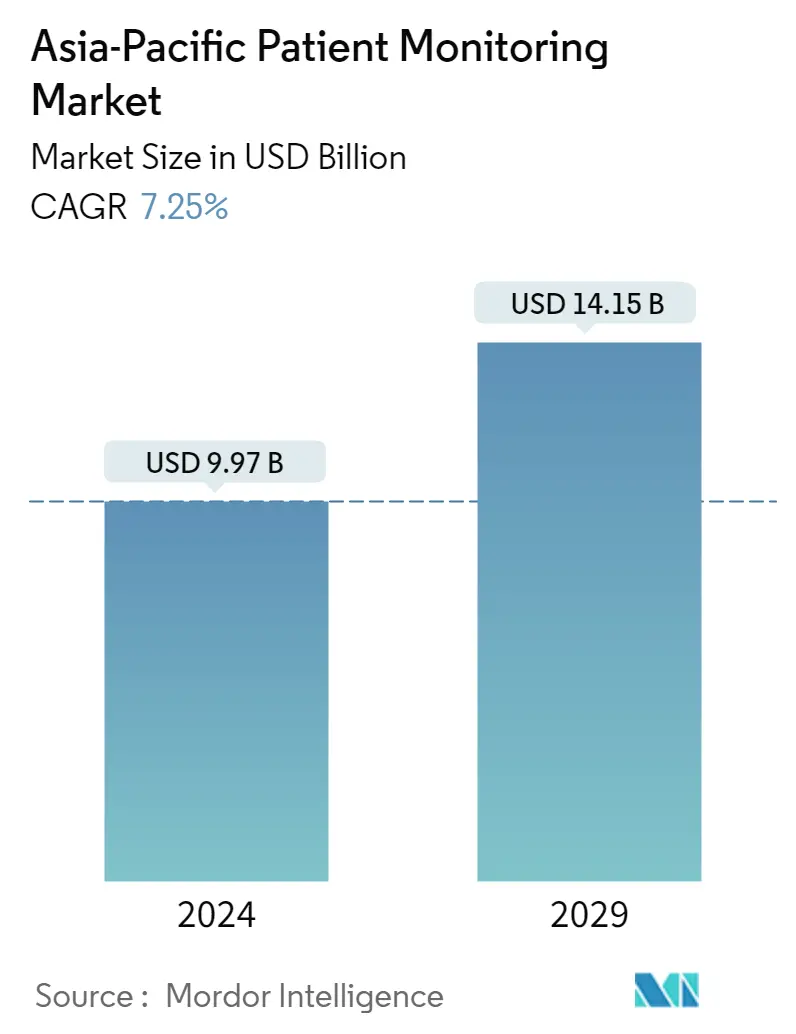Market Size of Asia-Pacific Patient Monitoring Industry

| Study Period | 2021 - 2029 |
| Base Year For Estimation | 2023 |
| Market Size (2024) | USD 9.97 Billion |
| Market Size (2029) | USD 14.15 Billion |
| CAGR (2024 - 2029) | 7.25 % |
| Market Concentration | Medium |
Major Players
*Disclaimer: Major Players sorted in no particular order |
Asia-Pacific Patient Monitoring Market Analysis
The Asia-Pacific Patient Monitoring Market size is estimated at USD 9.97 billion in 2024, and is expected to reach USD 14.15 billion by 2029, growing at a CAGR of 7.25% during the forecast period (2024-2029).
- The impact of COVID-19 was significant on the patient monitoring market owing to the increased remote patient monitoring for chronic diseases and elderly patients in the pandemic, which has propelled the market growth. The patient monitoring market has constantly been growing in the last two years due to its increasing demand, results, and convenience of patient healthcare. Various companies are engaged in launching technologically advanced patient monitoring solutions in the Asia Pacific region, which is further expected to boost market growth.
- For instance, in April 2022, South Korean telecommunication company KT announced the launch of a pilot telemedicine platform in Vietnam, with the aim of a soft landing within the next three years. The service will be designed to monitor people with chronic diseases like cancer, diabetes, and high blood pressure. Patients will be able to check their health, prescriptions, and exercise routines, as well as obtain counseling from Vietnamese medical professionals. Such initiatives are projected to boost the demand and launches of patient monitoring solutions, thereby boosting the market growth during the forecast period.
- In addition, the rising incidence of chronic diseases and increasing preference for home and remote monitoring are actively affecting the growth of the studied market.
- According to the Alzheimer's Disease Foundation, Malaysia (ADFM), the population of persons living with dementia was estimated to be around 204,000 to 264,000 (8.5% to 11%) in 2020, and this number is projected to reach 637,500 to 825,000 by the year 2050, an increase of 312%.
- Also, according to the International Diabetes Federation (IDF), 11,005 people had diabetes in 2021 Japan. In addition, this number is projected to reach 10,542.7 by 2030. The high blood sugar caused by diabetes can damage the nerves that control the heart and blood vessels, leading to a variety of cardiovascular diseases like coronary artery disease and stroke, which can narrow the arteries.
- This is anticipated to increase the need for monitoring glucose levels, blood pressure, and other activities, which are expected to increase the demand for monitoring devices that can provide data to physicians to help them more effectively evaluate patient conditions and react quickly to any abnormalities, thereby propelling the market growth during the forecast period.
- Various companies have been tracking the patient's vital signs for a long time and developing medication for the same. The key idea behind this is to measure lifestyle-related chronic disease development.
- For instance, in May 2022, a collaborative study effort was begun by Tohoku University's Tohoku Medical Megabank Organization, pharmaceutical companies Daiichi Sankyo and Takeda Pharmaceutical Co., and medical IT business MICIN to track long-term lifestyle patterns to guide the development of new treatments. The companies will provide wearable tracking devices to about 2,000 participants. Over a year, they will collect detailed and objective lifestyle data, such as sleep status, heart rate, and activity level.
- Therefore, owing to the aforementioned factors, the studied market is anticipated to witness growth over the analysis period. However, the high cost of devices is likely to impede the market growth.
Asia-Pacific Patient Monitoring Industry Segmentation
As per the scope of this report, patient monitoring devices are monitoring devices that continuously monitor the patient's vital parameters, like blood pressure and heart rate, by using a medical monitor and collecting medical (and other) data from individuals.
The Asia-Pacific patient monitoring market is segmented by type of device (hemodynamic monitoring devices, neuromonitoring devices, cardiac monitoring devices, multi-parameter monitors, respiratory monitoring devices, remote patient monitoring devices, and other types of devices), application (cardiology, neurology, respiratory, fetal and neonatal, weight management and fitness monitoring, and other devices), end-user (home healthcare, hospitals and clinics, and other end-users), and geography(China, Japan, India, Australia, South Korea, and Rest of Asia-Pacific).
The report offers the value (in USD million) for the above segments.
| By Type of Device | |
| Hemodynamic Monitoring Devices | |
| Neuromonitoring Devices | |
| Cardiac Monitoring Devices | |
| Multi-parameter Monitors | |
| Respiratory Monitoring Devices | |
| Remote Patient Monitoring Devices | |
| Other Types of Devices |
| By Application | |
| Cardiology | |
| Neurology | |
| Respiratory | |
| Fetal and Neonatal | |
| Weight Management and Fitness Monitoring | |
| Other Applications |
| By End-Users | |
| Home Healthcare | |
| Hospitals and Clinics | |
| Other End-Users |
| Geography | |
| China | |
| Japan | |
| India | |
| Australia | |
| South Korea | |
| Rest of Asia-Pacific |
Asia-Pacific Patient Monitoring Market Size Summary
The Asia-Pacific Patient Monitoring Market is poised for significant growth, driven by the increasing demand for advanced healthcare solutions and the rising prevalence of chronic diseases. The market has experienced a surge in demand due to the COVID-19 pandemic, which highlighted the importance of remote patient monitoring for managing chronic conditions and supporting elderly patients. Companies in the region are actively launching innovative monitoring solutions, such as telemedicine platforms and wearable devices, to enhance patient care and facilitate early disease detection. These advancements are expected to propel market growth, as they offer convenient and efficient ways to monitor health conditions remotely. The growing geriatric population and the escalating incidence of chronic diseases, such as diabetes and cardiovascular conditions, further contribute to the market's expansion, as there is an increasing need for effective monitoring devices that provide real-time data to healthcare providers.
India is anticipated to hold a significant share of the market, driven by its large and aging population, coupled with the rising prevalence of chronic diseases. The demand for remote patient monitoring solutions is particularly strong in India, as healthcare providers seek to manage the health of elderly patients more effectively. Strategic collaborations and partnerships, such as those between Dozee and Priaashraya Healthcare Pvt Ltd., are enhancing the capabilities of patient monitoring systems, allowing for continuous health monitoring and early intervention. The competitive landscape of the market is fragmented, with numerous global and regional players, including Koninklijke Philips N.V., General Electric Company, and Mindray Medical International Co. Ltd., actively participating in the market. These companies are focusing on expanding their product offerings and enhancing local manufacturing capabilities to meet the growing demand for patient monitoring solutions in the region.
Asia-Pacific Patient Monitoring Market Size - Table of Contents
-
1. MARKET DYNAMICS
-
1.1 Market Overview
-
1.2 Market Drivers
-
1.2.1 Rising Incidences of Chronic Diseases
-
1.2.2 Increasing Preference for Home and Remote Monitoring
-
-
1.3 Market Restraints
-
1.3.1 High Cost of Devices
-
-
1.4 Porter's Five Forces Analysis
-
1.4.1 Threat of New Entrants
-
1.4.2 Bargaining Power of Buyers/Consumers
-
1.4.3 Bargaining Power of Suppliers
-
1.4.4 Threat of Substitute Products
-
1.4.5 Intensity of Competitive Rivalry
-
-
-
2. MARKET SEGMENTATION (Market Size by Value- USD million)
-
2.1 By Type of Device
-
2.1.1 Hemodynamic Monitoring Devices
-
2.1.2 Neuromonitoring Devices
-
2.1.3 Cardiac Monitoring Devices
-
2.1.4 Multi-parameter Monitors
-
2.1.5 Respiratory Monitoring Devices
-
2.1.6 Remote Patient Monitoring Devices
-
2.1.7 Other Types of Devices
-
-
2.2 By Application
-
2.2.1 Cardiology
-
2.2.2 Neurology
-
2.2.3 Respiratory
-
2.2.4 Fetal and Neonatal
-
2.2.5 Weight Management and Fitness Monitoring
-
2.2.6 Other Applications
-
-
2.3 By End-Users
-
2.3.1 Home Healthcare
-
2.3.2 Hospitals and Clinics
-
2.3.3 Other End-Users
-
-
2.4 Geography
-
2.4.1 China
-
2.4.2 Japan
-
2.4.3 India
-
2.4.4 Australia
-
2.4.5 South Korea
-
2.4.6 Rest of Asia-Pacific
-
-
Asia-Pacific Patient Monitoring Market Size FAQs
How big is the Asia-Pacific Patient Monitoring Market?
The Asia-Pacific Patient Monitoring Market size is expected to reach USD 9.97 billion in 2024 and grow at a CAGR of 7.25% to reach USD 14.15 billion by 2029.
What is the current Asia-Pacific Patient Monitoring Market size?
In 2024, the Asia-Pacific Patient Monitoring Market size is expected to reach USD 9.97 billion.

